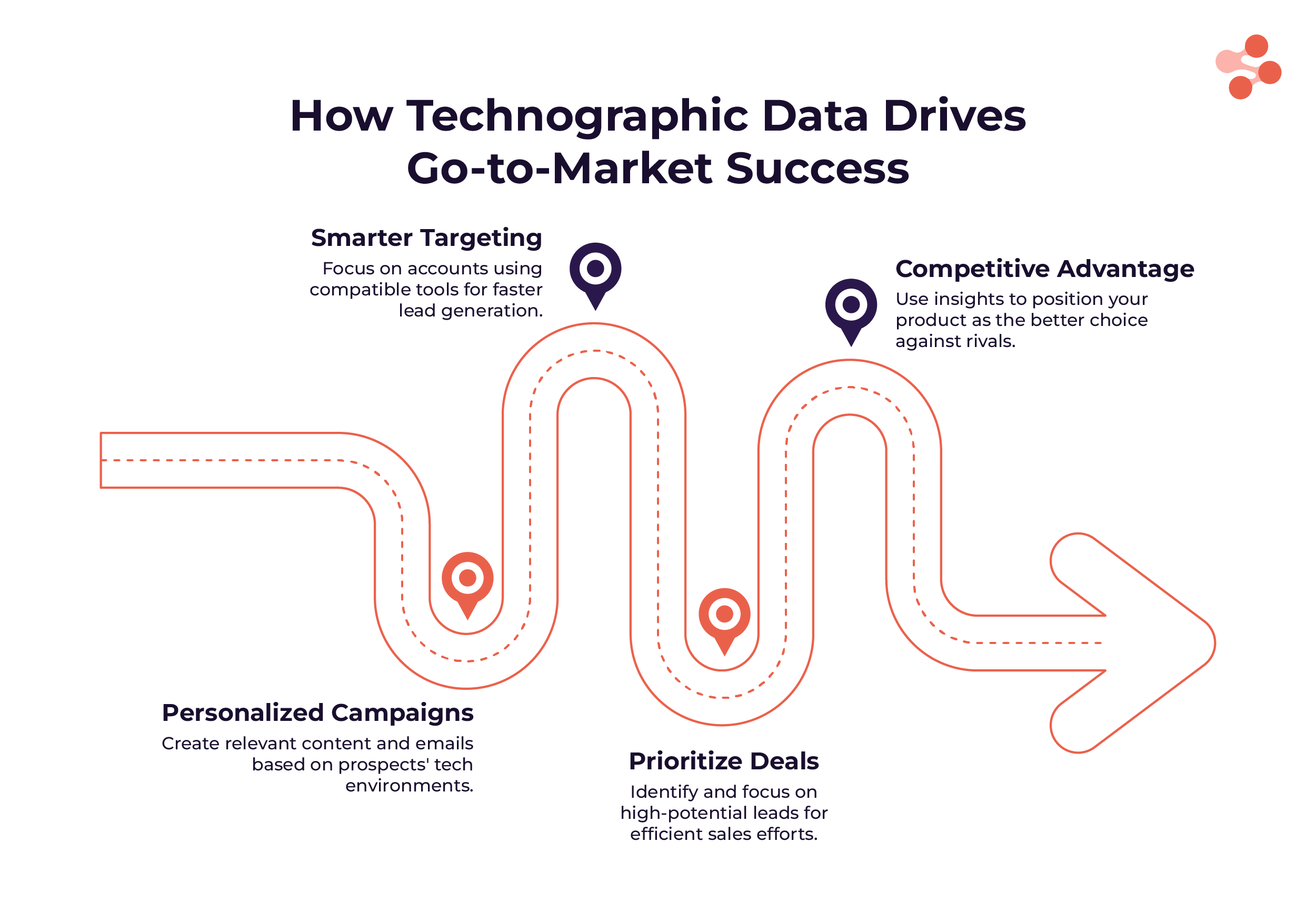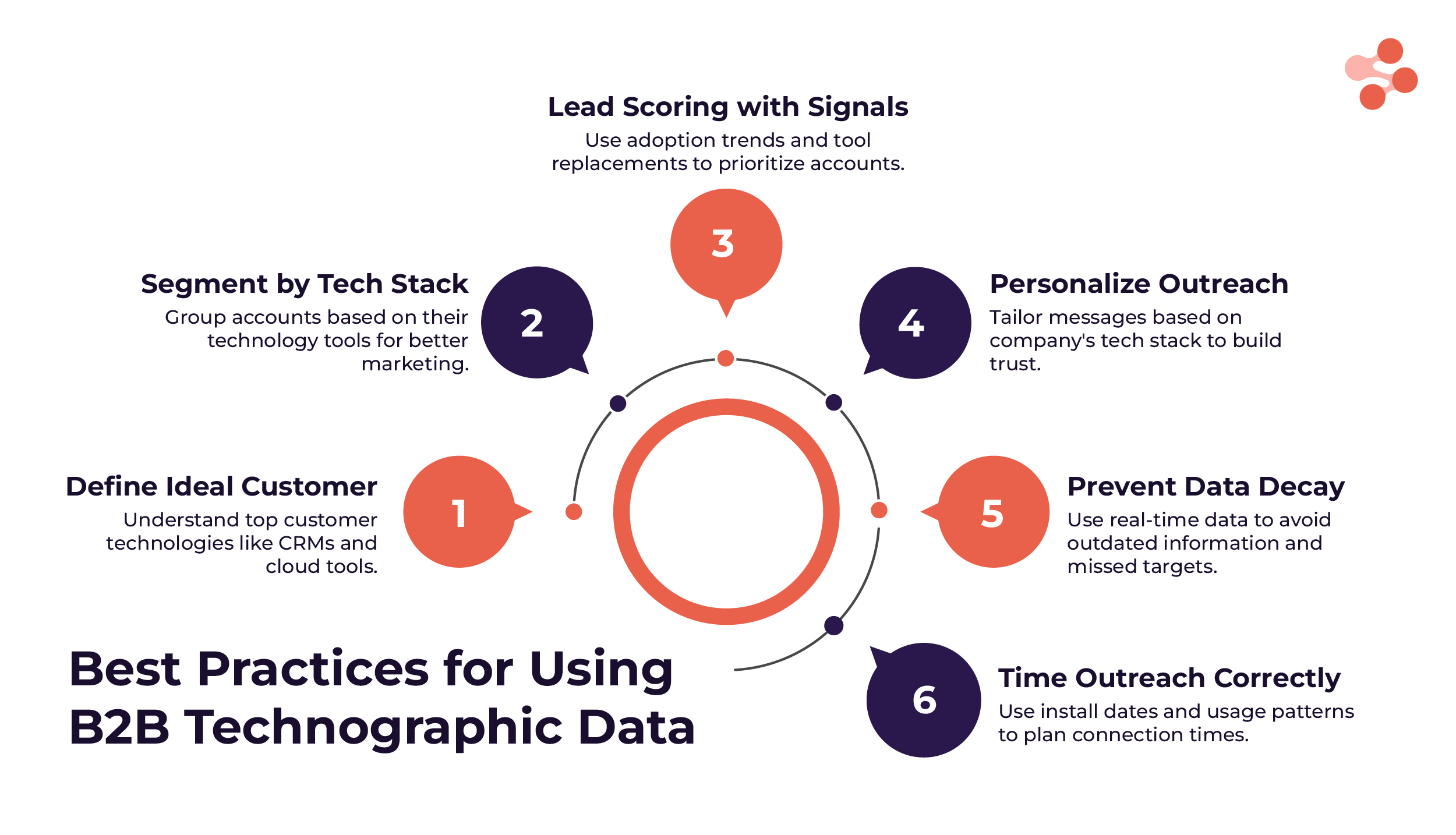All About Technographic Data:
Technographic data tells you what tools a company uses. CRM, marketing software, cloud platforms—you get the full picture. No guessing. No wasted outreach.
Still, most sales and marketing teams rely on firmographics and hope for the best. They pitch to companies without knowing if the tech even fits. It’s like selling snow boots in the desert.
The result? Low conversions. Burned-out reps. Campaigns that go nowhere.
Technographic data changes that. You know who to target, when to reach out, and what message to use.
In this guide, we’ll break down:
- What technographic data means
- Why it matters for your go to market strategy
- Key data points to track
- How to collect it the right way
- And how a provider like SMARTe gives instant insights so your team works smarter, not harder
If you're tired of cold leads and random pitches, this article is for you.
Let's get started.
What Is Technographic Data?
Technographic data shows which technologies a company uses. This includes software, hardware, tools, and digital platforms.
It goes beyond just naming products. It reveals versions, usage patterns, integrations, and how recently tools were adopted. You can also spot trends like AI adoption or cloud migration.
Unlike firmographic data (industry, size) or demographic data (job title, location), technographics tell you how a company runs its tech stack. It helps you understand their digital maturity and buying intent.
For B2B teams, this is gold. You can segment accounts, qualify leads, and pitch solutions that match the tools they already use—or need to replace.
Data is collected through web crawlers, job listings, data vendors, and tech tag tracking.
Used well, technographic data drives smarter outreach, sharper targeting, and better deal timing. It helps you sell into the stack, not just the company.
Benefits of Using Technographic Data in B2B Sales and Marketing
Technographic data gives B2B teams a sharp edge. It reveals what tools prospects already use—and where gaps exist. This insight turns guesswork into strategy.

1. Qualify Leads Faster
You don’t need to chase every lead. Focus on companies using tools that fit your product. This boosts conversion rates and reduces wasted effort. Selling into a compatible tech stack is faster and more predictable.
2. Create Laser-Focused Outreach
Know their tech, speak their language. Use technographics to tailor your emails, ads, and calls. Reference tools they already use. Suggest better alternatives. This kind of personalization improves response rates and builds trust early.
3. Improve Segmentation and Targeting
With technographic segmentation, you group accounts by the tools they already use—like CRMs, cloud platforms, or security software.
This lets you tailor your outreach to fit their exact setup.
Speak to their stack, not the crowd. The more relevant your message, the better your results. It’s how high-performing teams boost engagement and ROI.
4. Beat the Competition
See who’s using your competitors. Then show why you’re the better choice. You can highlight product gaps, cost advantages, or support differences. This opens doors for displacement and keeps your messaging sharp.
5. Prevent Churn Before It Happens
Track changes in your customers’ tech stack. If they adopt a tool that competes with yours, it’s a red flag. Reach out, re-engage, and reinforce your value before it’s too late.
6. Shorten the Sales Cycle
By targeting companies already familiar with similar tools, you reduce education time. Reps spend less time explaining and more time closing. That leads to faster deals and higher win rates.
7. Allocate Resources More Effectively
Not every lead deserves equal effort. Technographic insights help prioritize outreach. Focus on high-fit accounts. Save time, reduce costs, and increase marketing efficiency.
8. Drive Better ABM Results
Account-Based Marketing works best when it's hyper-targeted. Use tech data to build smart account lists. Customize messaging based on the buyer’s tech environment. The result? Higher engagement and pipeline velocity.
Technographic data gives B2B teams clarity. It helps you know who to target, what to say, and when to act. Used right, it improves every step of your sales and marketing strategy—leading to better leads, faster deals, and stronger customer relationships.
Key Technographic Data Points
These data points reveal how a company’s technology stack is built and used. They help B2B teams target accounts more accurately and tailor messaging with precision.
- Software: CRMs, ERPs, marketing tools, and productivity platforms
- Programming Languages: Python, Java, JavaScript, and more
- Frameworks: React, Angular, Node.js, etc.
- Operating Systems: Windows, Linux, macOS
- Web Servers: Apache, NGINX, IIS
- Databases: MySQL, MongoDB, PostgreSQL
- Cloud Providers: AWS, Azure, Google Cloud
- Security Tools: Firewalls, endpoint protection, and encryption
- SaaS Usage: Number and type of SaaS tools in use
- Integrations: How tools are connected (APIs, middleware)
- Tech Spend: Budget and frequency of upgrades
These data points help sales and marketing teams target better, personalize messaging, and spot accounts ready to buy.
Difference Between Demographic Psychographic Technographics and Firmographic Data
To build an effective B2B strategy, you need to understand your buyers from every angle. That’s where different types of data come in.
Demographic, psychographic, technographic and firmographic data each offer unique insights. Together, they help you segment your audience, personalize outreach, and increase conversions.
Here's how they differ:
How to Collect and Source Accurate Technographic Data
To get technographic data, you need a mix of trusted sources. Below are the most effective methods to collect accurate technographic data:
1. Use a Technographic Data Provider
The fastest and most reliable method is to use a dedicated technographic data provider like SMARTe.
SMARTe gives you unmatched visibility into your prospect’s tech stack.
It tracks over 59,000 technologies across millions of companies—covering CRMs, cloud platforms, analytics tools, marketing software, and more.
You’ll know what tools they use, when they adopted them, and how those tools are connected. These are the technographic signals your team needs to qualify and convert faster.
Every data point is cleaned, enriched, and verified with AI in real time. No outdated lists. No gaps.
Filter by industry, revenue, location, or company size. Build laser-focused account lists and sync them directly to your CRM.
Need to know if a company uses Salesforce, HubSpot, or Snowflake? SMARTe gives you that insight in seconds.
With SMARTe’s technographic data, you target smarter, close faster, and scale with confidence.
How to Get Technographic Data Using SMARTe
SMARTe makes it easy to find technographic data for your target accounts. Here's how:
1. Login to SMARTe
Use your credentials to log into the SMARTe dashboard.
2. Use the Filters
On the dashboard, you’ll see a range of filters on the right side. These include location, industry, revenue, headcount, department, seniority, keywords, and more.
3. Select the Technographic Filter
Scroll to find the Technographic filter. Use it to search by technologies like Salesforce, HubSpot, AWS, Shopify, etc. You can add one or more tools based on your targeting needs.
4. Click Search
Once you apply the filter, click Search to view the list of companies and contacts using those technologies.
5. Reveal the Contacts
Inside the result list, you’ll see contact profiles. Click Reveal to unlock the verified email address and phone number of each contact.
That’s it. You get complete contact and company-level technographic data in just a few clicks.
2. Analyze Company Websites
You can scan a company’s website to see which technologies are installed. This includes CMSs, chatbots, trackers, and email platforms.
Tools like BuiltWith or Wappalyzer can help. They inspect the source code and show you what’s running on the site.
This method only reveals public-facing tools. It won’t show internal platforms like CRMs or HR systems.
Use it for quick checks and surface-level insights.
3. Monitor Job Postings
Job listings can uncover the tools a company uses internally. If a business is hiring a Salesforce admin or AWS engineer, they likely use those platforms.
You can find this information on job boards or the company’s careers page. Some sales teams also use tools that scan job postings at scale.
This method is good for finding backend tools that aren't shown on websites.
4. Ask Directly Through Surveys or Forms
Sometimes, the most accurate way to get data is to ask for it. Add a question to your signup form, contact page, or discovery call.
Example: “What CRM are you currently using?”
You can also include this in onboarding flows or customer feedback surveys. These self-reported answers are usually reliable.
It’s a simple way to collect first-party technographic data.
5. Review Case Studies and Partner Pages
Companies often reveal the tools they use in customer stories, blog posts, testimonials, and partner directories.
These mentions help you confirm or enrich what you already know. You can also spot trends across similar businesses.
This method takes more manual effort but can be valuable for account-level research.
The fastest way to get accurate technographic data is by using a trusted provider like SMARTe.
It gives you verified, real-time insights into the tools your target accounts use.
This helps you understand your ideal customer profile more clearly what technologies they rely on, when they adopted them, and what they might need next.
With this data, you can identify the right accounts and engage them at the right time.
How Technographic Data Powers Go-to-Market Success
The best GTM teams don’t just look at who to target—they know why and when.
Used well, technographic data turns noise into signal. Here is how it helps the GTM teams:

1. Smarter Targeting for Faster Lead Generation
You don’t need to chase every company. With technographics, teams can focus only on accounts that already use tools your product fits well with. For example, if your product complements HubSpot, targeting users of HubSpot boosts results.
This kind of focused lead generation helps teams move faster. You get more demos, better conversations, and higher conversion rates.
2. Build Campaigns That Actually Connect
Generic messaging fails. Buyers today expect relevance.
Technographic data helps marketers create content and emails that match a prospect’s tech environment. If a company uses Salesforce, your pitch highlights your Salesforce integration.
If they’re using outdated tools, your message shows why it’s time for an upgrade. This makes your go to market strategy stronger and your outreach more personalized.
It’s what great SaaS go to market strategy looks like in action.
3. Outperform Competitors with Timely Intel
Seeing a prospect using a rival tool? That’s your window.
You can create displacement campaigns that position your product as the better choice. Whether it’s easier to use, more secure, or cheaper, your message hits home because it’s based on facts—not fluff.
Many GTM teams also use this data to track shifts in adoption, so they can respond before the competition does. That’s how you stay ahead.
4. Prioritize the Right Deals and Avoid Wasting Time
Technographic data shows you exactly what go-to-market tools your prospects are already using. This helps you instantly spot where your solution fits in—or where there's a gap you can fill.
You can score and route leads based on tool compatibility or replacement signals. Reps focus on accounts where the tech stack aligns, and the value proposition is clear.
No more chasing poor-fit leads. With technographic insights, your sales motion becomes faster, smarter, and more precise.
5. Spot Risk and Uncover New Opportunities
When a customer changes their stack—adds or drops a tool—it can be a sign. They might be growing. Or preparing to leave.
GTM teams that track these signals can act early. Retention plays, upsells, and expansion offers all work better when they’re timely. You’re not reacting—you’re leading.
Technographics also reveal market trends. That helps teams refine their pitch, shape their product roadmap, and adjust the GTM tech stack to stay relevant.
Technographic data isn’t just a list of tools. It’s insight. It helps GTM teams act faster, sell smarter, and connect deeper. With the right strategy, it’s not just data—it’s a competitive edge.
Best Practices for Using B2B Technographic Data

- Define Your Ideal Customer Profile (ICP): Use technographics data to understand what technologies your top customers use. Focus on CRMs, cloud tools, analytics platforms, and other systems that match your offer.
- Segment by Tech Stack: Group accounts based on the tools they rely on. This improves your marketing data and makes outreach more relevant.
- Use Technographic Signals for Lead Scoring: Look at adoption trends, tool replacements, and upgrade cycles. Combine this with your lead generation data to prioritize the right accounts.
- Personalize Your Outreach: Tailor messages based on a company’s tech stack. Mention the tools they use and show how your product fits in. These boosts reply to rates and build trust.
- Stay Ahead of B2B Data Decay: Tools change. Teams switch platforms. If your data is old, your outreach will miss the mark. Fight B2B data decay by using a real-time technographic data provider like SMARTe.
- Reach Out at the Right Time: Use install dates and tech usage patterns to plan when to connect. Good B2B data tells you not just who to target, but when.
Know Your Prospect's Tech Stack with SMARTe
Stop guessing what tools your buyers use. SMARTe tracks over 59,000 technologies and shows you what each company is using—from SaaS tools to IT systems.
Find the right accounts. Write messages that feel personal. Win deals before your competitors even see them.
SMARTe gives you access to 281 million contacts, 65 million company profiles, and real-time data updates. You connect only with companies already using tools like yours.
Join 320+ global companies who trust SMARTe for clean, accurate, and compliant B2B data.
Book your demo now and start selling like you already know their tech stack (because you do).










